
- 歌曲
- 时长
简介
Rafael Andia专辑介绍:Just as little is known about the composer Robert de Visée as about most 17th C composers, yet some curious facts are known about Visée as a guitarist and lutenist. He really did get called regularly to Louis XIV's bedchamber in order to play the Sun King to sleep! He was Louis's own guitar teacher, for which service he was paid royally and appointed a court Singer though there's no record indicating that he had a voice. Two volumes of his music specifically for guitar were published in 1682 and 1686. He also composed a larger body of music for Theorbo and Baroque Lute, which has survived only in manuscript. The baroque guitar and the lute were less 'interchangeable' instruments in Visée's era than they might seem today. Both the technique of playing and the occasions of playing were distinct, for which reason the repertoires for the two instruments cannot and should not be performed in the same manner. Visée's compositions make the distinction quite audible. His lute music is gravely contrapuntal, serene, intellectual. His guitar music is brusquely rhythmic, harsher than what one might expect from the small guitar of the era, and quite insistently structured by the fashionable dances of the court. Historically, both the guitar and the violin were still perceived to be instruments of the dance and of dance masters. The guitar served as a dance instrument because of its capability of being strummed across its five strings, yielding almost percussive figures called "batteries". The strings were strummed or plucked with the nails rather than with the fleshy tips of the fingers as was done with the lute. The player and the composer were admonished to know the steps of the dances and to stress the proper beats relentlessly. Dance masters used a pendulum to "define" the proper tempi of dances, and composers were not permitted much slack. A century before the metronome, therefore, we can be very certain of the tempi of much French Baroque music. The dances played by Rafael Andia on this CD were grouped by Visée as "suites" -- allemande, courante, gavotte, sarabande, etc -- and thus prepared for concert performance as well as for actual dancing. Visée was known to have performed such concerts for Madame de Maintenon and other favorites of the Court. Courtiers around Louis XIV had a special royal dispensation to perform on stage as dancers in the operas of Lully, though they couldn't be allowed to "condescend" to play in Lully's orchestra. Music like Visée's guitar dances would have accompanied their stately but athletic choreographies. As a composer of music for theorbo/lute, Visée was unmatched in France in her era. His work probably was known to Sylvius Weiss of Germany, the finest of all Baroque lutenists and lute composers. I like Visée's lute music much more than this guitar music, perhaps because I'm a dancer with two left feet. The musicology and the dance-scholarship upon which Rafael Andia has reconstructed his baroque guitar technique is very convincing, but honestly I don't relish the results wholeheartedly. It's a brittle sound and a harsh timbre, a virtuosity that I admire more than enjoy.




